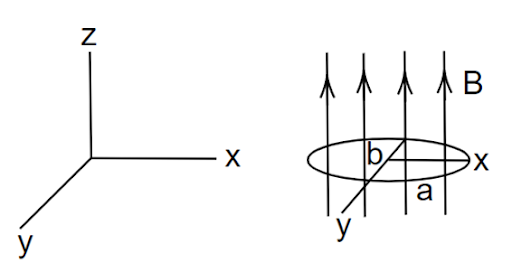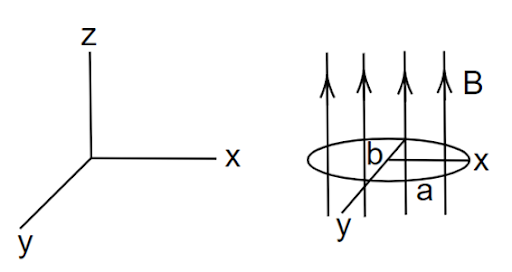
An elliptical loop having resistance R, of semi-major axis a, and semi-minor axis b is placed in the magnetic field as shown in the figure. If the loop is rotated about the x-axis with angular frequency \[\omega \], Find the average power loss in the loop due to Joule heating.

A. \[\dfrac{{\pi abB\omega }}{R}\]
B. \[\dfrac{{{\pi ^2}{a^2}{b^2}{B^2}{\omega ^2}}}{R}\]
C. \[\dfrac{{{\pi ^2}{a^2}{b^2}{B^2}{\omega ^2}}}{{2R}}\]
D. Zero
Answer
216.6k+ views
Hint: Induced emf is defined as the generation of a potential difference in a coil due to the change in the magnetic flux through it. In other words, electromotive Force or EMF is said to be induced when the flux linking with a conductor or coil changes. We are going to use the expressions of magnetic flux and average power loss to answer this question.
Formula Used:
The formula to find the flux is,
\[\phi = \overrightarrow B \cdot \overrightarrow A \]
Where, \[\overrightarrow B \] is magnetic field and \[\overrightarrow A \] is area of loop.
The formula to find the average power loss is,
\[P = \dfrac{{{e^2}}}{R}\]
Where, e is induced emf and R is resistance.
Complete step by step solution:

Image: An elliptical loop having resistance R, of semi-major axis a, and semi-minor axis b is placed in the magnetic field.
Consider an elliptical loop having resistance R, of semi-major axis a, and semi-minor axis b which is placed in the magnetic field as shown in the figure. When the loop is rotated about the x-axis with angular frequency\[\omega \], then we need to find the average power loss in the loop due to Joule heating. We know the formula to find the flux is,
\[\phi = \overrightarrow B \cdot \overrightarrow A \]
\[\Rightarrow \phi = BA\cos \theta \]
Since \[\omega \] is angular frequency, in place of \[\theta \] we write\[\omega t\], then the above equation will become,
\[\phi = BA\cos \omega t\]
We know that, the induced emf is,
\[e = - \dfrac{{d\phi }}{{dt}}\]
\[\Rightarrow e = - \dfrac{{d\left( {BA\cos \omega t} \right)}}{{dt}}\]
\[\Rightarrow e = BA\sin \omega t \times \omega \]……… (1)
We know that, the area of ellipse is,
\[A = \pi ab\]
Substitute the area of ellipse in equation (1) we get,
\[e = \pi abB\sin \omega t \times \omega \]
The average power loss is,
\[P = \dfrac{{{e^2}}}{R}\]
\[\Rightarrow P = {\dfrac{{{\pi ^2}{a^2}{b^2}{B^2}{{\sin }^2}\left( {\omega t} \right) \times \omega }}{R}^2}\]
The average value of \[{\sin ^2}\theta = \dfrac{1}{2}\]
Then,
\[P = {\dfrac{{{\pi ^2}{a^2}{b^2}{B^2}\omega }}{{2R}}^2}\]
Therefore, the average power loss in the loop due to Joule heating is \[{\dfrac{{{\pi ^2}{a^2}{b^2}{B^2}\omega }}{{2R}}^2}\].
Hence, option C is the correct answer.
Note: In order to resolve this problem, it is important to remember the formula for flux in a coil, induced emf, average power loss and area of the ellipse. Moreover, a measurement of the total magnetic field that traverses a specific region is called magnetic flux. It is a helpful tool for explaining how the magnetic force affects things inhabiting a certain region. The precise area selected will determine how magnetic flux is measured.
Formula Used:
The formula to find the flux is,
\[\phi = \overrightarrow B \cdot \overrightarrow A \]
Where, \[\overrightarrow B \] is magnetic field and \[\overrightarrow A \] is area of loop.
The formula to find the average power loss is,
\[P = \dfrac{{{e^2}}}{R}\]
Where, e is induced emf and R is resistance.
Complete step by step solution:

Image: An elliptical loop having resistance R, of semi-major axis a, and semi-minor axis b is placed in the magnetic field.
Consider an elliptical loop having resistance R, of semi-major axis a, and semi-minor axis b which is placed in the magnetic field as shown in the figure. When the loop is rotated about the x-axis with angular frequency\[\omega \], then we need to find the average power loss in the loop due to Joule heating. We know the formula to find the flux is,
\[\phi = \overrightarrow B \cdot \overrightarrow A \]
\[\Rightarrow \phi = BA\cos \theta \]
Since \[\omega \] is angular frequency, in place of \[\theta \] we write\[\omega t\], then the above equation will become,
\[\phi = BA\cos \omega t\]
We know that, the induced emf is,
\[e = - \dfrac{{d\phi }}{{dt}}\]
\[\Rightarrow e = - \dfrac{{d\left( {BA\cos \omega t} \right)}}{{dt}}\]
\[\Rightarrow e = BA\sin \omega t \times \omega \]……… (1)
We know that, the area of ellipse is,
\[A = \pi ab\]
Substitute the area of ellipse in equation (1) we get,
\[e = \pi abB\sin \omega t \times \omega \]
The average power loss is,
\[P = \dfrac{{{e^2}}}{R}\]
\[\Rightarrow P = {\dfrac{{{\pi ^2}{a^2}{b^2}{B^2}{{\sin }^2}\left( {\omega t} \right) \times \omega }}{R}^2}\]
The average value of \[{\sin ^2}\theta = \dfrac{1}{2}\]
Then,
\[P = {\dfrac{{{\pi ^2}{a^2}{b^2}{B^2}\omega }}{{2R}}^2}\]
Therefore, the average power loss in the loop due to Joule heating is \[{\dfrac{{{\pi ^2}{a^2}{b^2}{B^2}\omega }}{{2R}}^2}\].
Hence, option C is the correct answer.
Note: In order to resolve this problem, it is important to remember the formula for flux in a coil, induced emf, average power loss and area of the ellipse. Moreover, a measurement of the total magnetic field that traverses a specific region is called magnetic flux. It is a helpful tool for explaining how the magnetic force affects things inhabiting a certain region. The precise area selected will determine how magnetic flux is measured.
Recently Updated Pages
Wheatstone Bridge Explained: Working, Formula & Uses

Young’s Double Slit Experiment Derivation Explained

JEE Atomic Structure and Chemical Bonding important Concepts and Tips

JEE Amino Acids and Peptides Important Concepts and Tips for Exam Preparation

Electricity and Magnetism Explained: Key Concepts & Applications

Chemical Properties of Hydrogen - Important Concepts for JEE Exam Preparation

Trending doubts
JEE Main 2026: Application Form Open, Exam Dates, Syllabus, Eligibility & Question Papers

Derivation of Equation of Trajectory Explained for Students

Hybridisation in Chemistry – Concept, Types & Applications

Understanding the Angle of Deviation in a Prism

Understanding Collisions: Types and Examples for Students

How to Convert a Galvanometer into an Ammeter or Voltmeter

Other Pages
JEE Advanced Marks vs Ranks 2025: Understanding Category-wise Qualifying Marks and Previous Year Cut-offs

Understanding Atomic Structure for Beginners

Ideal and Non-Ideal Solutions Explained for Class 12 Chemistry

Degree of Dissociation: Meaning, Formula, Calculation & Uses

Understanding Electromagnetic Waves and Their Importance

Understanding the Electric Field of a Uniformly Charged Ring




